If you have found a plant with yellow flowers in your garden or lawn but are unsure of it, this guide is for you. There is a good chance that this unidentified plant is a weed. Weeds with yellow flowers might make kids excited, but it is a nightmare for most gardeners.
Most gardeners and lawn care services suggest that active weed control is needed for keeping your lawn healthy. Weeds can rob your lawns and gardens of space, water, sunlight, and nutrients. In addition, some lawn weeds can also attract wildlife that may eat or move around, deteriorating the lawn conditions even further.
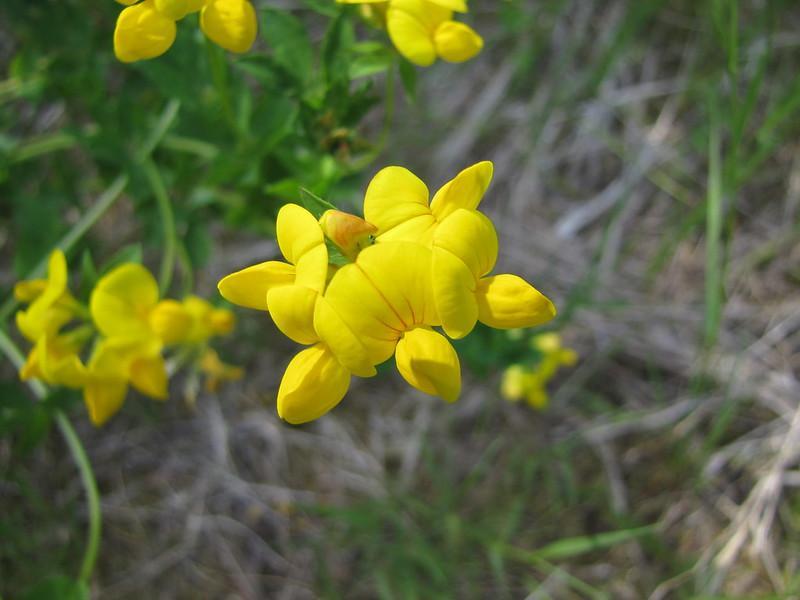
Lawn weeds are a common household problem. Sometimes they grow so vigorously that they can end up suffocating the grass.
While we do not promote actively eradicating all the weeds in your lawn as some weeds can attract beneficial insects or bring nutrients and water up from deep in the soil. However, it is probably worth your time to learn about the different types of weeds.
By better understanding common lawn weeds, you can decide which ones you can keep and which ones you need to remove from the lawn.
This article will provide you with a comprehensive guide on common weeds with yellow flowers. You will learn how to identify a particular weed and what time of the year you should expect to see it in your lawn.
However, that is not all; we will also tell you about different weed control practices and lawn care techniques to keep your lawn and grass healthy. Happy reading!
Common Lawn Weeds With Yellow Flowers
1. Bird’s Foot Trefoil

Bird’s Foot Trefoil has been declared invasive in Minnesota, United States.
Bird’s foot trefoil is a clover-like plant with a sprawling growth pattern. It is often used as forage for sheep and cattle in many areas of the United States.
Bird’s Foot Trefoil forms dense mats thanks to its creeping stems. These dense mats can shade and choke out other vegetation present underneath.
Bird’s Foot Trefoil can be easily recognized by its bright yellow flowers that are present in whorls of three to eight. The stems are either erect or lying on the ground in a semi-erect position.
Bird’s Foot Trefoil is very tolerant of adverse conditions. It can easily grow in low pH and poorly drained garden beds.
It is an invasive weed, and the best way to avoid spreading it in your lawn is to avoid introducing it in the first place. Clean your gear and boots after a hike, and keep an eye out on your lawn.
However, if you are already dealing with this lawn weed, do not worry! The root system only penetrates to around two to three feet, and the plant can easily be uprooted.
Bird’s Foot Trefoil Quick Facts
| Scientific Name | Lotus corniculatus |
| Other Names | Eggs and bacon, birdsfoot deervetch |
| Weed Type | Perennial herbaceous |
| Height | – 5 to 20 cm – Around 50 cm when supported by other plants or objects |
| Flowering | – June to September – Flowers develop in small legumes or pea-like pods |
| Habitat and Distribution | – Predominantly found in sandy soils – Also present in roadsides, grass places, and fields – Native to Eurasia and North Africa. However, it has a worldwide distribution now |
2. Dandelions
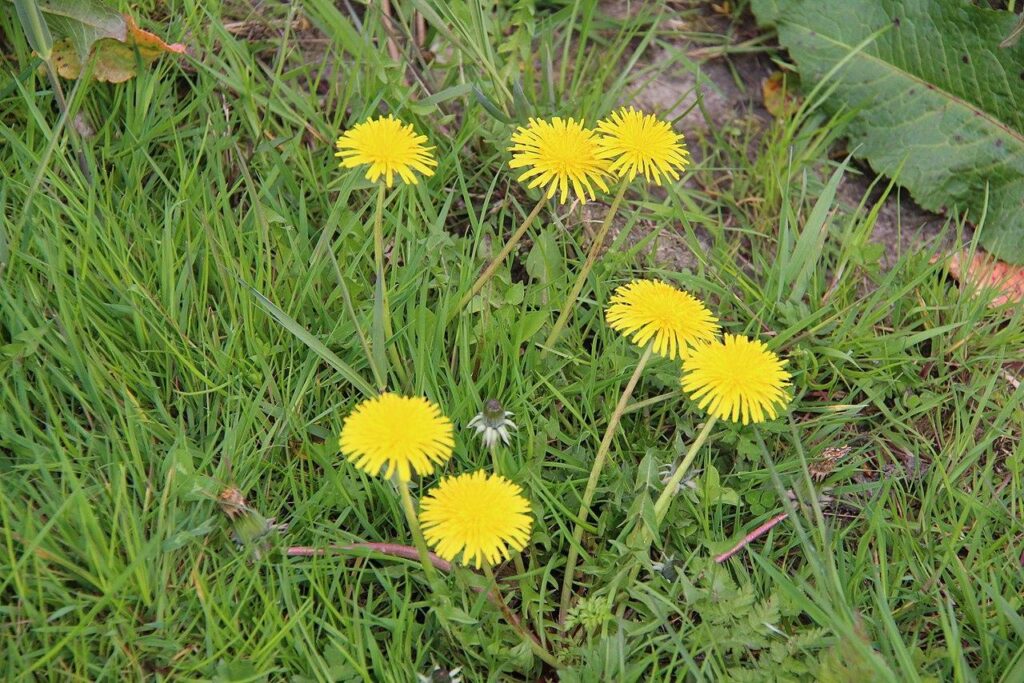
Dandelions flowers are made of several individual ray-shaped flowers clustered together
Dandelions are broadleaf weeds that are popular amongst kids. You must have seen children blowing dandelion seeds into the air after making a wish. Unfortunately, dandelions often steal precious lawn space from other desirable plants as they grow in dense clusters.
Dandelions have a deep root system, making hand removal difficult for the established plants. The best way to get rid of these garden weeds is to use a pre-emergent herbicide or a commercially available broadleaf herbicide.
Although dandelions are a common lawn weed, they have many herbal uses. Moreover, dandelions are also a good source of pollen and nectar for some beneficial insects.
RELATED: Common Weeds That Look Like Grass (and How To Get Rid Of Grassy Weeds)
Dandelions Quick Facts
| Scientific Name | Taraxacum (A genus containing around 60 species) |
| Other Names | Lion’s tooth, blow-ball, Irish daisy, pissinlit, puffball, tell-time, yellow gowan |
| Weed Type | A broadleaf perennial weed |
| Height | – 5 to 40 cm tall on average – Sometimes, dandelions can grow as tall as 70 cm |
| Flowering And Leaves | – Starts in late March and continues into the fall – Bright yellow flowers atop hollow stalks – – White flowers and purple flowers also exist – Plant has dark green leaves |
| Habitat And Distribution | – Native to Eurasia and North America – However, spread throughout most of the world – Common in cultivated areas and wasteland |
3. Wild Parsnip
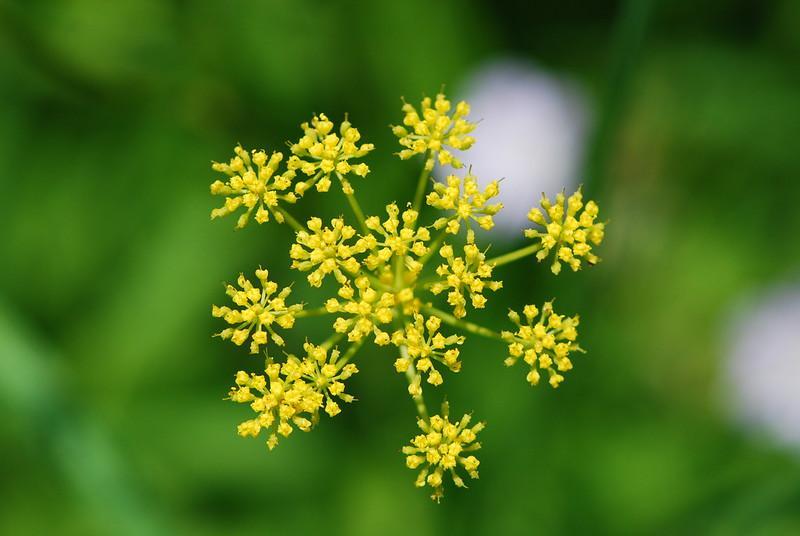
Wild parsnip produces light yellow flowers in small clusters.
Wild parsnip is a perennial plant that belongs to the carrot family. This plant species has a reputation for spreading aggressively. The weed seeds are produced in seed heads which are carried by water and wind. These aggressive plants produce yellow flowers in the form of clusters. Wild parsnips form dense mats that can spread quickly and take out existing plants of the area.
You should note that the sap from parsnip plants can cause severe skin burns. So, it is better to be cautious during weed control efforts. You can also try to use a suitable weed killer to take out this garden weed.
Wild Parsnip Quick Facts
| Scientific Name | Pastinaca sativa |
| Other Names | Poison parsnip |
| Weed Type | A biennial weed |
| Height | 0.5 to 1.5 m tall |
| Flowering & Leaves | – Tiny yellow flowers in clusters – June through late August – The plant has bright green leaves |
| Habitat And Distribution | – Native to Eurasia – Widespread throughout the United States except for Florida, Alabama, and Hawaii – Habitat includes roadsides, field margins, and forests |
4. Oxalis
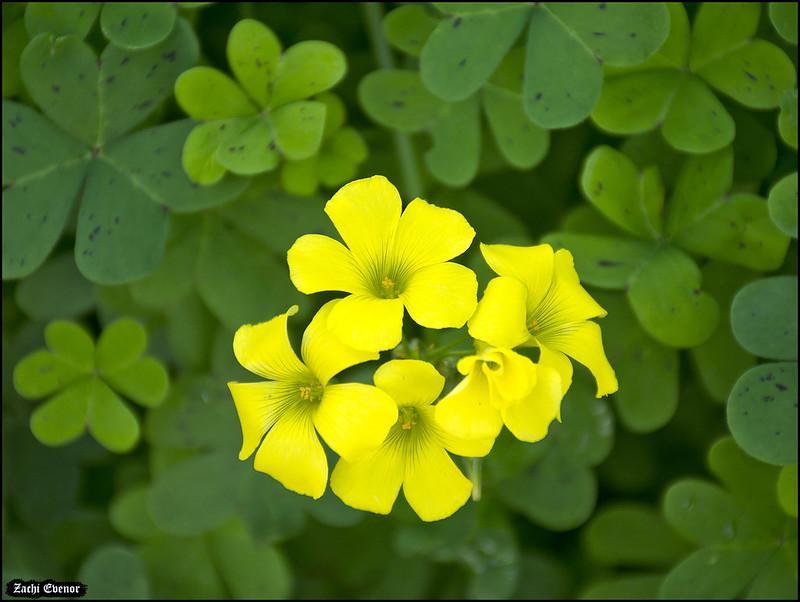
One way to prevent Oxalis plants from growing is to maintain a thick lawn
Many types of oxalis are ornamental plants. However, a few of these can become weeds and compete with other desirable plants in the garden. Oxalis plants are annual or perennial weeds. Some species of oxalis also have edible tubers or roots.
Weed control is difficult as the oxalis plant grows relatively quickly, often suffocating other new plants in the area. These plants have creeping stems with clover-like leaves. The best way to get rid of Oxalis species is to use a pre-emergent herbicide. Maintaining a thick lawn can also prevent weeds from growing.
Oxalis Quick Facts
| Scientific Name | Oxalis (A genus containing around 500 species) |
| Other Names | Wood sorrels, yellow sorrels, sour grasses, false shamrocks |
| Weed Type | – Annual or perennial – Examples: Oxalis corniculata grows as an annual weed whereas, Oxalis debilis grows as a perennial weed |
| Height | Most species are around one foot tall |
| Flowering & Leaves | – Flowers bloom from spring to autumn – Small yellow flowers with five petals – Plants usually have dark green leaves |
| Habitat And Distribution | – This genus is distributed throughout the world, except in polar areas – Very common in Brazil, South Africa, and Mexico – Found in lawns, flower beds, and pastures |
RELATED: What Is The Best Way To Kill Weeds Permanently? A Simple & Easy Guide
5. Creeping Buttercup
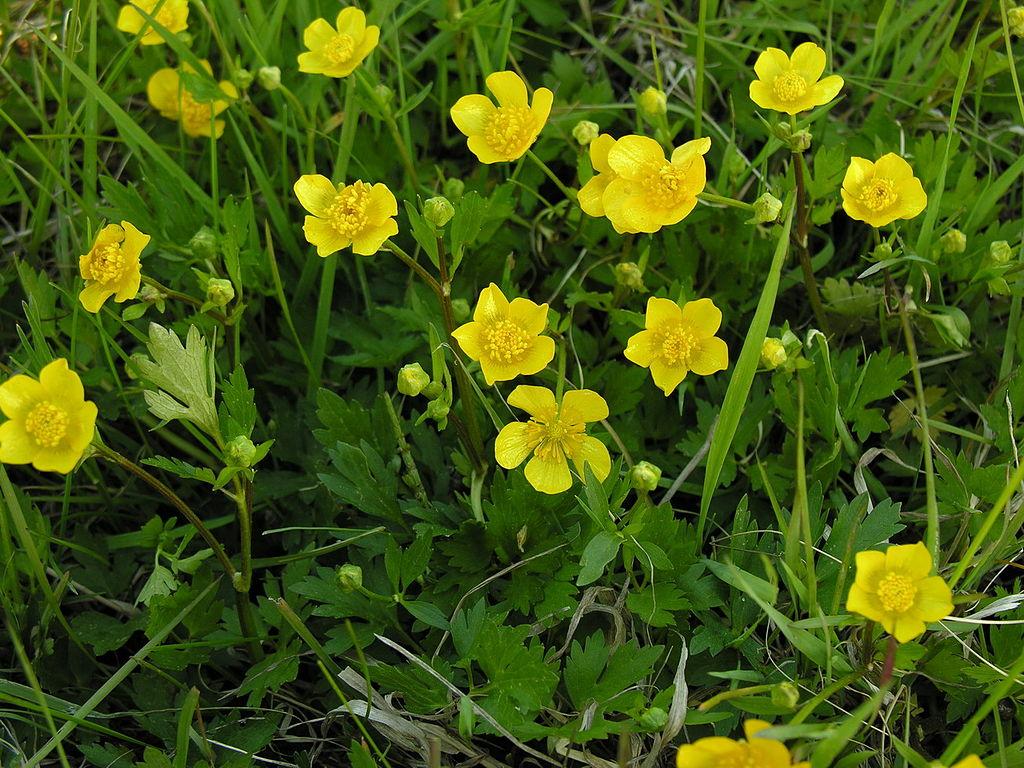
A grassy weed that produces rather attractive flowers
Creeping buttercup is a common lawn weed that has rather pretty yellow flowers. These small flowers attract pollinating insects; however, like other broadleaf weeds, they can quickly grow and compete for resources with the native plants. This common lawn weed is usually found in wet soil,
The fibrous roots can survive acidic soil and compacted soil conditions and can also give rise to new plants. Since buttercup has relatively shallow roots, pulling it out during daily lawn care can help you get rid of these common weeds.
Creeping Buttercup Quick Facts
| Scientific Name | Ranunculus repens |
| Other Names | Creeping crowfoot, sitfast |
| Weed Type | A herbaceous perennial weed |
| Height | Up to 50 cm tall |
| Flowering & Leaves | – Flowers bloom from early summer to early fall – The plant has light green leaves – Leaves are borne on long stalks with fine hairs |
| Habitat And Distribution | – Native to Europe, Asia, and Africa – Common weeds of gardens and agricultural land – Prefers damp or flooded areas |
6. Common Purslane
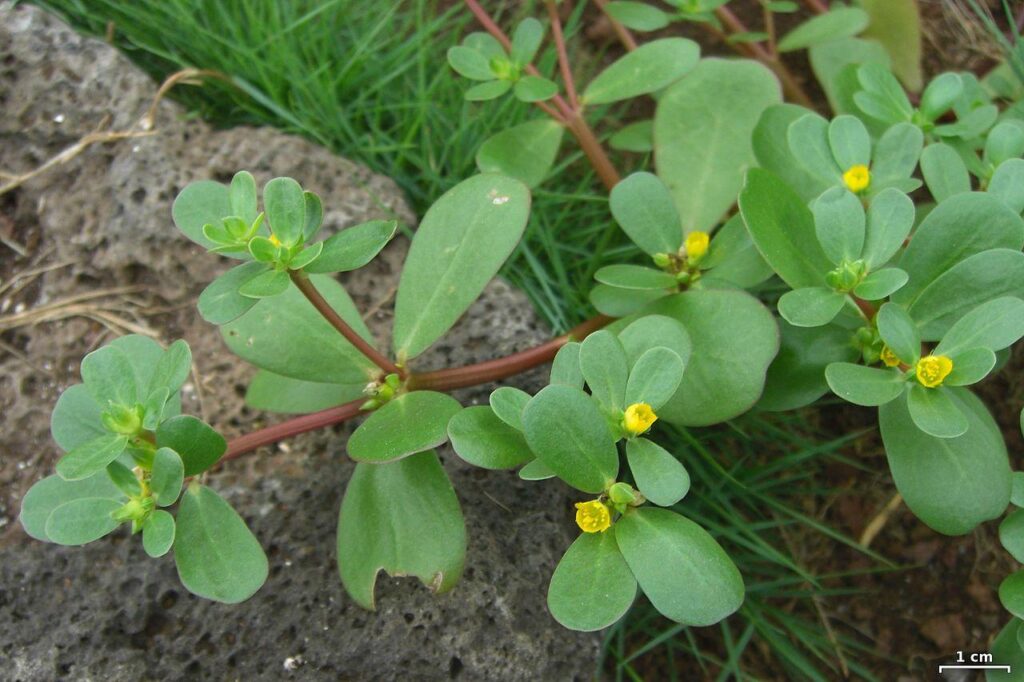
Common purslane has dark green leaves and is considered very nutritious.
Common purslane is another weed that produces yellow flowers. This annual weed is considered quite nutritious as it contains many vitamins, antioxidants, and omega-3-fatty acids.
The weed is also used as fodder for poultry and ointment for skin burns. It has succulent leaves and reddish stems.
The stems arise from a single root, and depending on moisture availability; they are low-growing or erect. These common weeds are known for their persistence.
They can generally grow in dry wastelands and can even retain enough moisture to ripen seed heads long after being uprooted.
Common Purslane Quick Facts
| Scientific Name | Portulaca oleracea |
| Other Names | Pursley, little hogweed |
| Weed Type | Succulent annual weed |
| Height | – Usually low-lying – Sometimes can rise as much as one and a half feet |
| Flowering & Leaves | – Flowers can appear any time of the year, depending on rainfall – Small yellow flowers with notched petals – Clover like leaves |
| Habitat And Distribution | – Distributed throughout temperate and tropical regions of the world – In the United States, common in northeastern states – Habitats include barnyards, nurseries, croplands, rocky bluffs, and pathways |
7. Yellow Salsify
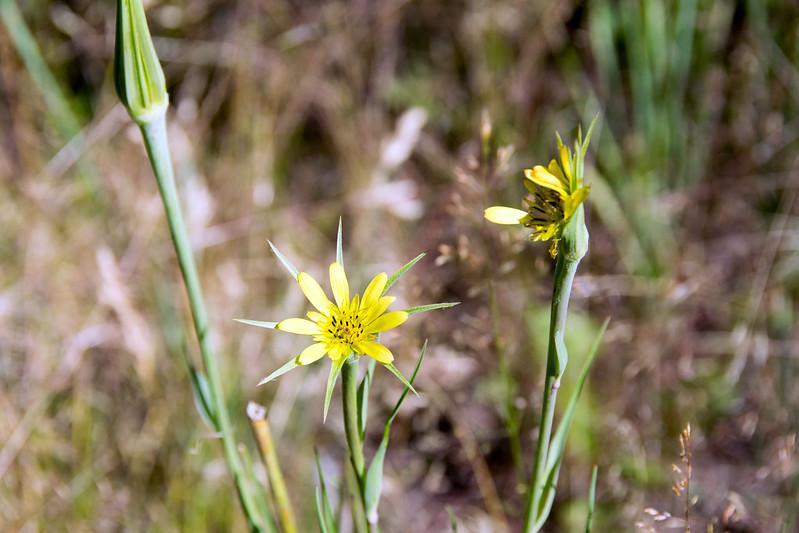
Yellow salsify has handsome seed heads that are very prominent, like dandelions.
Yellow salsify is a common weed found along roadsides, abandoned agricultural fields, and pastures. A significant reason for its overgrowth is the fact that animals avoid eating it because of its bitter taste.
Even though these common weeds prefer full sunlight, they are also somewhat shade tolerant. Yellow salsify has long, thin leaves with smooth edges and a pointed tip.
You can mulch garden beds to prevent yellow salsify from spreading. Also, do not try to use it in compost. Its seeds can stay dormant for quite a long time and quickly take over if spread in the lawn.
Yellow Salsify Quick Facts
| Scientific Name | Tragopogon dubius |
| Other Names | Western goat’s-beard, wild oyster plant, western salsify |
| Weed Type | Annual forb and occasionally biennial as well |
| Height | – Usually anywhere between 20 to 60 cm – However, sometimes, it can reach a height of a meter |
| Flowering & Leaves | – Flowering occurs during late spring or early summer – Inflorescence contains yellow flowers – Plant has green leaves that are long and narrow |
| Habitat And Distribution | – Native to southern and central Europe – Introduced and widespread in the United States – Habitat includes grasslands, shrublands, forests, and woodlands |
8. Yellow Rocket
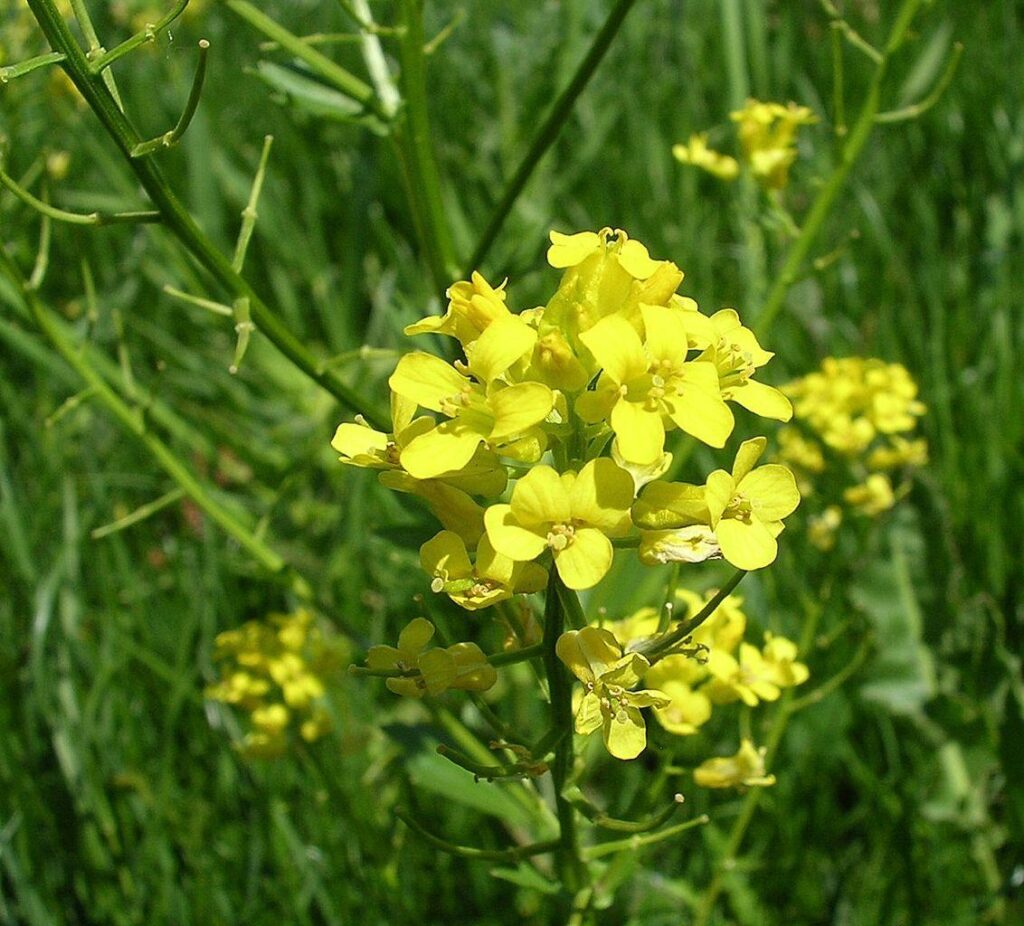
Yellow rocket oil is used extensively as hair oil in many regions of the world
Yellow rocket is a member of the mustard family, and it is the first one to flower in the mustard group. Yellow rocket plants are common weeds of nursery crops, small grains, and pastures. Animals also avoid overeating these common weeds as they cause digestive irritation.
As these weeds emerge during the fall, fall and early winter are an excellent time to control their spread. Early yellow rocket plants are easily uprooted by hand, but already established plants are challenging to get rid of.
There are also many broadleaf herbicides available in the market that negatively affect yellow rocket plants as well. However, before using any general herbicide, you should consult a professional.
Yellow Rocket Quick Facts
| Scientific Name | Barbarea vulgaris |
| Other Names | Winter rocket, herb barbara, rocket cress, wintercress, wound rocket |
| Weed Type | A broadleaf biennial or perennial herb with a short life span |
| Height | – Usually around 30 to 60 cm tall – Sometimes can grow as tall as one meter |
| Flowering & Leaves | – Flowers bloom from April to July – The plant has small yellow flowers produced in abundance – Leaves are dark green and do not clasp the stem |
| Habitat And Distribution | – Native to Eurasia and North Africa – A weed in many parts of North America and New Zealand – Habitat includes roadsides, fields and construction sites, agricultural fields, etc. |
9. Canada Goldenrod
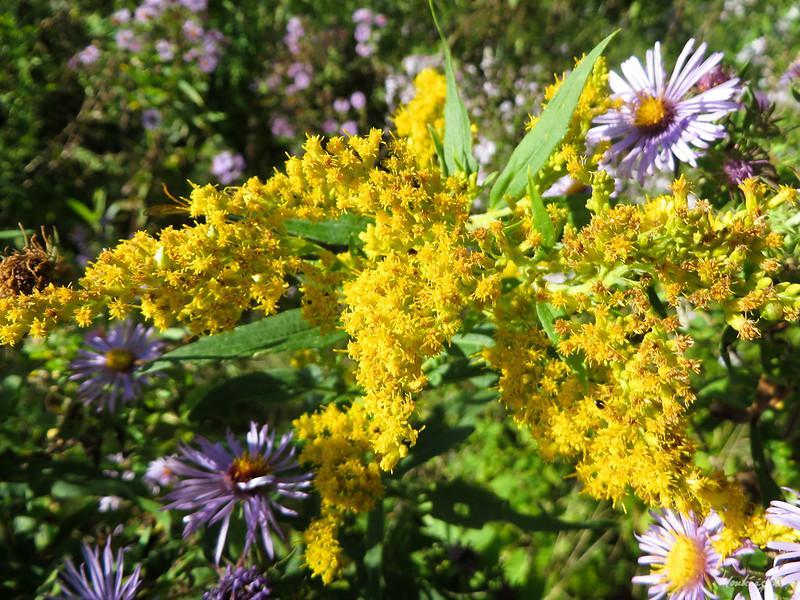
It is a highly invasive plant that quickly spreads through native plants and gardens.
It is native to North America. However, it has spread extensively to several European countries after being introduced there as an ornamental plant. As a result, the plant has been declared invasive in around 13 countries. Its removal is also thought to be relatively expensive.
Even though the Canada goldenrod is beneficial for pollinating insects, it grows very aggressively and tends to make monocultures. The plant spreads rapidly via its seeds, and it can also develop through rhizomes. However, that’s not all; the Canada goldenrod also has a very tough root system and can also survive extreme cold and hot temperatures.
It is considered a serious threat to native plants and floral biodiversity in some areas.
Yellow Rocket Quick Facts
| Scientific Name | Solidago canadensis |
| Other Names | Canadian goldenrod |
| Weed Type | A herbaceous perennial plant/weed |
| Height | – Normally, the plant is 2 to 4 feet tall – Sometimes, the plant can grow as tall as 6 feet |
| Flowering & Leaves | – Flowers bloom from July to October – The small yellow flowers make a pyramid-like formation – Leaves are prominently toothed |
| Habitat And Distribution | – Native to North America – Introduced, widespread and invasive in many European countries – Common habitats include disturbed areas such as floodplains, gravel steeps, thickets, savannas, etc. |
10. Common Ragwort
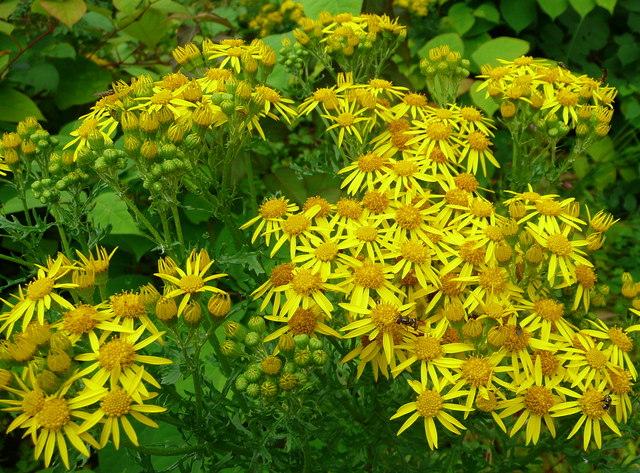
Common ragworts are popular flowering weeds among butterflies.
It is a common weed of pastures and wastelands that occurs in almost every country of the United Kingdom. These common weeds are tolerant to frost and are also known to have some tolerance against desiccation and drought. The weed is usually not a common issue in gardens; however, it can spread very quickly.
The weed is also harmful to livestock. The seeds are usually spread by wind. To get rid of ragwort plants, try your best to do it manually using a hand or other garden gear. However, you can use chemical control methods after professional guidance if necessary.
Common Ragwort Quick Facts
| Scientific Name | Jacobaea vulgaris |
| Other Names | Tansy ragwort, benweed, staggerwort, dog standard, cankerwort, stammerwort |
| Weed Type | – Considered herbaceous biennial but shows perennial tendencies |
| Height | 0.3 to 2 meters tall on average |
| Flowering & Leaves | – Flowers bloom from June to November – Yellow flowers with daisy-like heads – Leaves are dark green and have ear-like lobes |
| Habitat And Distribution | – Native to northern Eurasia – Widely spread, from Scandinavia to the Mediterranean – Habitat includes humid temperate areas – Abundant in wastelands, waysides, and grazing pastures |
11. Creeping Cinquefoil

Creeping cinquefoil plants, though attractive, can quickly become a nuisance due to their aggressive growth.
Even though its bright and attractive yellow flowers make it an aesthetic sight alongside roads and banks, creeping cinquefoil can rapidly become a nuisance in garden beds, lawns, and borders due to its quick growth. A single plant can produce 15 runners, each of which can have 20 root nodes capable of forming a deep taproot network.
At the start of infestation, when these weed plants are relatively young, you can try to pull them out by hand to get rid of them. However, once established, you will need some sort of chemical weed control to remove these weeds.
Creeping Cinquefoil Quick Facts
| Scientific Name | Potentilla reptans |
| Other Names | European cinquefoil, creeping tormentil |
| Weed Type | A creeping flowering perennial weed |
| Height | 10 to 15 cm tall |
| Flowering & Leaves | – Flowers bloom between June and August – Each flower has five heart-shaped petals – Leaves are palmate and divided into leaflets with toothed edges |
| Habitat And Distribution | – Native to Eurasia and Northern Africa – Introduced in the United States and relatively common throughout Britain & Ireland – Habitats include urban wasteland, upland hill slopes, roadside laybys, etc. |
12. Marsh Yellowcress
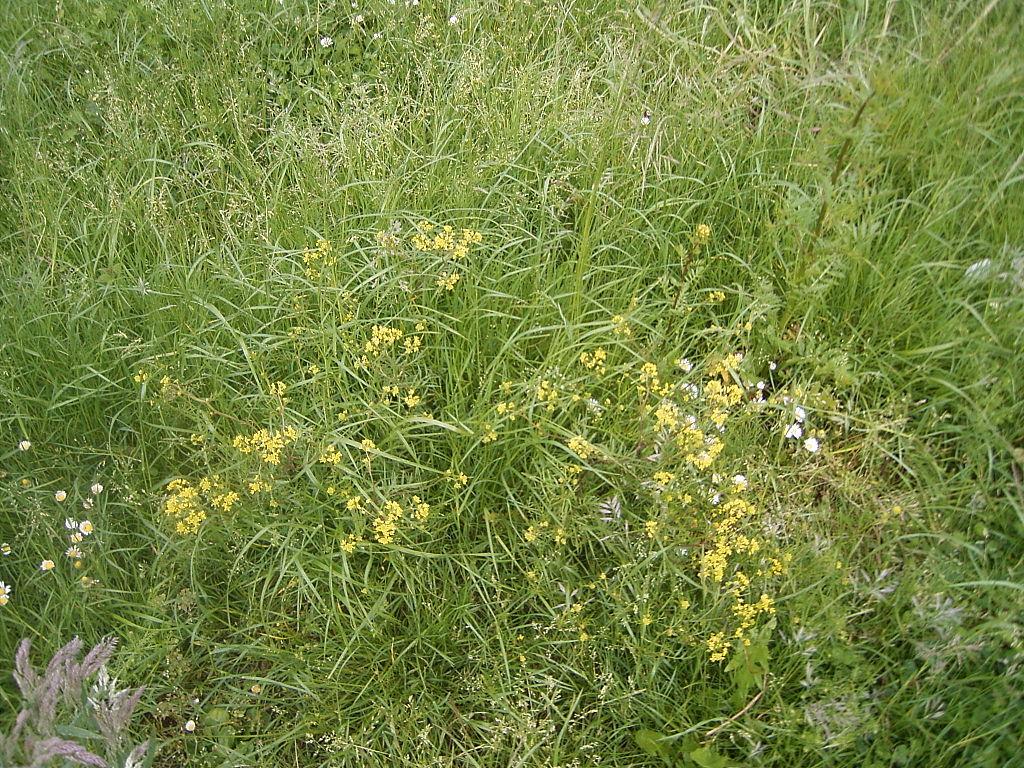
Marsh yellowcress is a common weed in Australia and South America.
It is a relatively short-lived plant that often becomes a weed problem for small fruit, vegetable, and nursery crops. The weed can grow in a wide range of conditions, but it thrives in poorly-drained and nutrient-rich soil.
Managing and controlling marsh yellowcress is not particularly difficult. Like most broadleaf weeds, you can pull out or uproot newly germinated weeds. Yet, chemical control might become necessary if the weed has taken hold of an area.
Marsh yellowcress is, however, not all bad; it attracts various pollinating insects, which could be beneficial for your garden.
Marsh Yellowcress Quick Facts
| Scientific Name | Rorippa palustris |
| Other Names | Bog marsh cress, bog yellowcress, yellow cress, yellow watercress |
| Weed Type | Annual, biennial, and short-lived perennial |
| Height | 10 to 60 cm tall on average |
| Flowering & Leaves | – Starts in summer and lasts for almost two months – Flowers are 2 to 3 mm in diameter and have six petals – Leaves are alternated and petiolated with lobes at the tips |
| Habitat And Distribution | – Native and wids[read in parts of Asia, Europe, North America, and the Caribbean – Habitat includes damp, moist, and wet areas |
Frequently Asked Questions (FAQs)
What weeds have tiny yellow flowers?
There are several weeds with tiny yellow followers. Other than the types mentioned above, other common weeds with yellow flowers are Narrow-Leaf Plantain, Yellow Nutsedge, Yellow Sorrel, Golden Clover, Lesser Celandine, Black-Eyed Susans, Cypress Spurge, etc.
However, you must keep in mind that some of these plants are not always classified as weeds. Some of them are, in fact, ornamental or otherwise beneficial plants. However, due to their aggressive growth rate, they sometimes can become a nuisance and invasive weeds.
How do I get rid of yellow flowering weeds?
If you caught weeds growing at an early stage, you could simply uproot them using your hands. However, already established weed plants might need chemical control.
The nature of chemical control will vary from type to type. Also, do not use an all-purpose herbicide in your lawn or garden unless really necessary. It can harm other desirable plants in the garden, leaving you with nothing!
What are tiny yellow flowers in my lawn?
If it is not something you have planted or grown yourself, it is probably a weed with yellow flowers. Weeds can run havoc on your garden if not taken care of promptly.
They can compete with the desirable plants in the garden, suffocating them of sunlight, water, and nutrients. So, if you have found an unidentified yellow flower in your lawn, read our guide to find out which weed it is and what are appropriate control methods for it.
Sources for Further Reading
- Herbaceous Broadleaf Weeds: Yellow Flowers – Cooperative Extension: Maine Wild Blueberries – University of Maine Cooperative Extension. (2022). Retrieved 6 April 2022, from https://extension.umaine.edu/blueberries/weed-images/herbaceous-broadleaf-weeds/yellow-flowers/
- Spring blooming lawn and garden weeds: A focus on winter annual identification and management. (2021). Retrieved 6 April 2022, from https://www.canr.msu.edu/news/spring-blooming-lawn-and-garden-weeds
- Massey University, N. (2022). Creeping Oxalis – Massey University. Retrieved 6 April 2022, from https://www.massey.ac.nz/massey/learning/colleges/college-of-sciences/clinics-and-services/weeds-database/creeping-oxalis.cfm
Now that you know about weeds with yellow flowers, make sure to check out our other articles:
A Place In The Sun: The Ultimate Guide To Sunflowers
Se-Dum Beautiful! The Ultimate Guide To Sedum Flowers
As Fresh As A Rose: The Ultimate Guide To Rose Of Sharon Flowers







